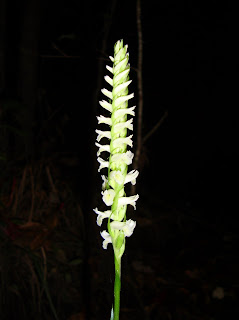Since we focused primarily on salamanders, I'll begin with some of them.

These bright orange and black Cave Salamanders (Eurycea lucifuga) are one of my favorites (not sure how many favorites I have). They really like the twilight zones of caves, where they are adept at roving along vertical surfaces, as well as hiding in tight crevices, sometimes in groups (below).


Pigeon Mountain Salamanders (Plethodon petraeus) are also found in the twilight zone, but where Cave Salamanders can be found in at least 13 states, Pigeon Mountain Salamanders only occur in caves around Pigeon Mountain in NW Georgia. One neat thing about this species is that the brown blotching on their backs allows them to blend in very well in the clay-covered surfaces just inside the cave entrance.

I'll never complain (I actually probably will) about easy-to-find animals that I'm interested in finding, but sometimes it's more satisfying to have to climb to the top of a mountain to find the subject of interest. That was the case for the five Weller's Salamanders (Plethodon welleri) that I was fortunate enough to find. Their patchy metallic markings on a black background color is very beautiful to me.

Oddly-colored Eastern Redback Salamanders (Plethodon cinereus) were found in slightly lower elevations in the same general area as the Weller's. They usually don't exhibit metallic markings on the head and tail like this one. It made me wonder if there is some hybridization going on.

Another high-elevation species is the Jordan's Salamander (Plethodon jordani). The simplicity of an all black animal with red cheek patches makes for a very pleasing appearance. Unfortunately, my camera died before I got a photo I really liked of this species (yeah, I'm making excuses).

Once considered part of the same species, the Northern Graycheek Salamander (Plethodon montanus) is almost identical to Jordan's Salamander but for the gray cheeks instead of red.

This Chattahoochee Slimy Salamander (Plethodon chattahoochee) is one of 13 slimy salamander species, all of which exhibit the general white spots on black pattern, though each with unique differences.


Salamanders in the genus Desmognathus have only mildly interested me in the past, but my appreciation has grown as I've seen more of their diversity of appearance and habits. The semi-aquatic Blackbelly Salamander (Desmognathus quadramaculatus) is the largest species in the genus, topping out at over eight inches.

The more terrestrial Pygmy Salamander (Desmognathus wrighti) is on the other end of the size spectrum, not exceeding two inches. They usually aren't found on orchid leaves unless I put them there for a photo.

We saw a few frogs and toads, including this Upland Chorus Frog metamorph (Pseudacris feriarum).
Now, for some bonus non-herp material before getting to the snakes.

When limited on time, we resort to herping more and resting less. Occasionally, a tired herper needs a good Dogfish Head 60-minute IPA as refreshment. This was right before heading up a mountain.

There were lots of beautiful Spring flowers blooming in some areas, including this iris...

...and these trilliums.

In the cave at Pigeon Mountain, Eastern Pipistrelle Bats (Pipistrellus subflavus) were constantly flying past me, sometimes even briefly landing on me. This one was cleaning itself while taking a break from hunting.

My excursions take me through some interesting areas, both naturally and culturally. This hippy-style pizza place on a river in the middle of nowhere was a welcome sight at lunch time one day.
Though it was still a bit cool in some areas, there were some snakes on the move.
This young Timber Rattlesnake (Crotalus horridus) was an exciting find crossing the road at night.

This Eastern Worm Snake (Carphophis amoenus amoenus) was found near the entrance to a cave.

Northern Ringneck Snakes (Diadophis punctatus edwardsii) can be abundant under logs and rocks in some areas. These two were found under the same rock.

This young Eastern Kingsnake (Lampropeltis getula getula) was only the second one I've seen, but it was the first one I've had a chance to photograph. Its perfect shiny scales made me think it had recently shed. King snakes eat other snakes; sometimes venomous ones, whose venom they are impervious to.



















